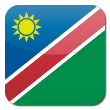It was formally known as the Sperrgebiet National Park. Tsau //Khaeb National Park (Tsau meaning Soft and //Khaeb meaning Sand) is newly proclaimed jewel in Namibia’s protected area network. Since 1908 the largest part of the Tsau //Khaeb National Park was left undisturbed and closed to the public for nearly a century following the discovery of a diamond at Kolmanskop near Lüderitz by the railway worker, Zacharias Lewala. Although this was done to protect the mineral wealth of the area, it also contributed to safeguarding the Succulent Karoo ecosystem, which has the highest diversity of succulent flora globally.
The park has giant rock arches, meteor craters, fossil and archaeological sites including Africa’s most important shipwreck discovery and some of the most pristine and wild landscapes on the planet. Some 1 050 plant species are known to occur in the park, nearly 25% of the entire flora of Namibia on less than three per cent of the land area of the country. This led to the listing of the Succulent Karoo as one of the world’s top 34 ‘biodiversity hotspots’. Tsau //Khaeb National Park is one of a ‘new era’ of protected areas, proclaimed to protect biodiversity while contributing to the local and national economy through tourism development and concessioning.
Park size: 22 000 km²
Proclamation: 2008
Natural features: Sandy shores along the coast in the south androcky headlands and inlets in the north. 17 islands occur off the coast adjoining the SNP. Sandy and gravel inland plains, sand dunes, mountain ranges and inselbergs and the Orange River valley.
Vegetation: Succulent Karoo, Namib Desert and Savannah biomes. Vegetation types: Succulent Steppe, Southern Desert, Riverine Woodland. Quiver tree (Aloe dichotoma), many-stemmed quiver tree (Aloe ramosissima), vygies (Mesembryanthemum sp), Hoodia and Euphorbia spp. Sweet-thorn (Acacia karoo), camel-thorn (Acacia erioloba) along riverbeds.
Wildlife: Brown hyaena, Oryx, Springbok, Cape fur seal, Grey rhebock, Heaviside’s dolphin, Southern right Whale. Almost 60 wetland birds along the Orange River and 120 terrestrial bird species recorded. African Penguin, Cape Gannet, Bank Cormorant, Purple Heron, Lappet-faced Vulture, Karoo Korhaan, Ludwig’s Bustard, Cape Francolin. Almost 100 reptile species; 16 frog species and a great number of insects and other invertebrates, probably 90 per cent or more of the invertebrates found in the park have not been described by science.

